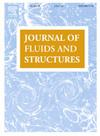Mitigating unsteady loads at low Reynolds numbers using a passive trailing-edge flap
IF 3.5
2区 工程技术
Q1 ENGINEERING, MECHANICAL
引用次数: 0
Abstract
The load mitigation potential of a passive pitching trailing edge flap for NACA0012 airfoils at a Reynolds number of 1000 subjected to oscillations in the angle of attack is analyzed. For this purpose, direct numerical simulations of the two-dimensional, incompressible flow have been conducted to examine the effectiveness of the flap in reducing aerodynamic load fluctuations across a range of oscillation amplitudes and flap-to-chord ratios. The validity of a quasi-steady model to predict the load mitigation using passive pitching flaps, previously proposed in the literature and predicting a load mitigation proportional to the flap-to-chord length ratio, , is here investigated for large amplitude oscillations. The results show that the increment in the reduction in fluctuations is generally proportional to the increment in . This closely aligns with the predictions of the quasi-steady theory, even for the cases with the largest oscillation amplitudes, where non-linear aerodynamic effects are present, although some variation is observed. Notably, we explored the interaction between vortical structures and the flap dynamics, and its relevance on the flow patterns around the airfoil and ultimately on load mitigation. This interaction, alongside flap inertia, provides insight into the timing and magnitude of load reduction, demonstrating the potential of tailored passive pitching mechanisms for unsteady flow conditions. These findings offer valuable insights for the design and development of passive unsteady load mechanisms for small aerial and underwater vehicles, as well as microscale energy harvesters, by highlighting the relevance of considering non-linear effects in their optimization.
利用被动尾缘襟翼减轻低雷诺数下的非定常载荷
分析了NACA0012型被动俯仰后缘襟翼在雷诺数为1000时受迎角振荡影响的减载潜力。为此,对二维不可压缩流动进行了直接数值模拟,以检验襟翼在振荡幅度和襟翼弦比范围内减少气动载荷波动的有效性。本文研究了准稳态模型的有效性,该模型用于预测使用被动俯仰襟翼的负载缓解,该模型先前在文献中提出,并预测了与襟翼与弦长比(a/c)成比例的负载缓解,用于大振幅振荡。结果表明,波动减少的增量一般与a/c的增量成正比。这与准稳定理论的预测密切一致,即使在振荡幅度最大的情况下,非线性气动效应也存在,尽管观察到一些变化。值得注意的是,我们探索了涡旋结构和襟翼动力学之间的相互作用,以及它与翼型周围流动模式的相关性,并最终与负载缓解有关。这种相互作用与襟翼惯性一起,提供了对载荷减少时间和幅度的深入了解,展示了针对非定常流动条件量身定制的被动俯仰机制的潜力。这些发现通过强调在优化中考虑非线性效应的相关性,为小型空中和水下航行器以及微型能量采集器的被动非定常负载机制的设计和开发提供了有价值的见解。
本文章由计算机程序翻译,如有差异,请以英文原文为准。
求助全文
约1分钟内获得全文
求助全文
来源期刊

Journal of Fluids and Structures
工程技术-工程:机械
CiteScore
6.90
自引率
8.30%
发文量
173
审稿时长
65 days
期刊介绍:
The Journal of Fluids and Structures serves as a focal point and a forum for the exchange of ideas, for the many kinds of specialists and practitioners concerned with fluid–structure interactions and the dynamics of systems related thereto, in any field. One of its aims is to foster the cross–fertilization of ideas, methods and techniques in the various disciplines involved.
The journal publishes papers that present original and significant contributions on all aspects of the mechanical interactions between fluids and solids, regardless of scale.
 求助内容:
求助内容: 应助结果提醒方式:
应助结果提醒方式:


